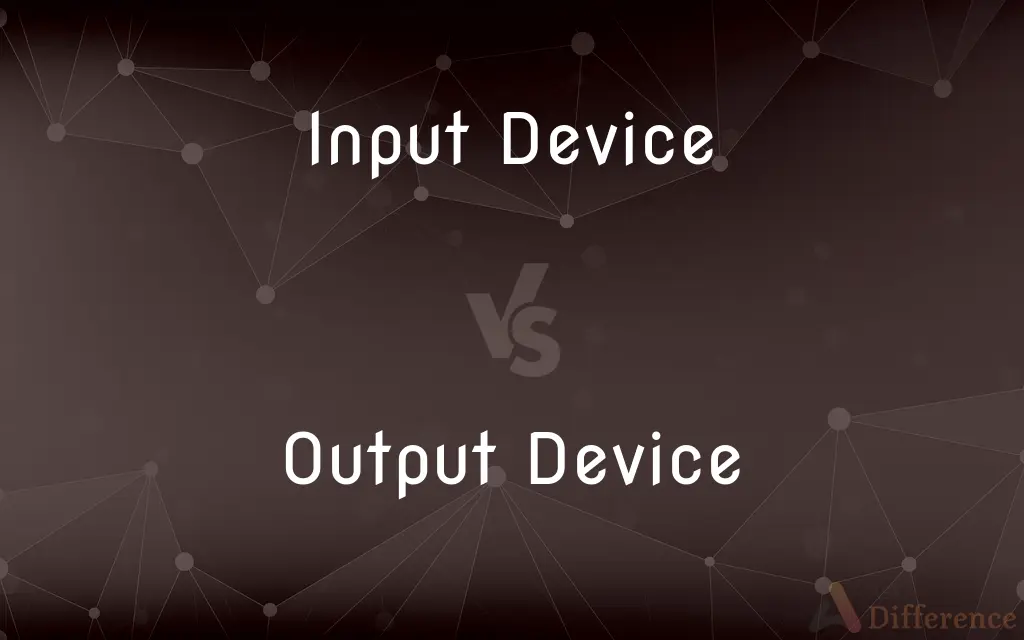Input Device vs. Output Device — What's the Difference?
Edited by Tayyaba Rehman — By Fiza Rafique — Published on December 20, 2023
An Input Device sends data to a computer for processing, like a keyboard, while an Output Device displays or produces results from the computer, like a monitor.

Difference Between Input Device and Output Device
Table of Contents
ADVERTISEMENT
Key Differences
An Input Device is any hardware component that provides data to a computer system for processing. This can include devices like keyboards, mice, and scanners. Conversely, an Output Device is a piece of hardware that receives processed data from the computer to present it to the user or another system. Examples are monitors, printers, and speakers.
The primary role of an Input Device is to allow users to communicate or command the computer system. This communication is achieved by entering data or commands. On the other hand, an Output Device takes this processed data and presents it in a form that's interpretable by users or other systems, ensuring feedback from the computer system.
When considering the flow of information, an Input Device is the starting point, capturing raw data. This data undergoes processing within the computer system. Post processing, the Output Device serves as the endpoint, delivering the results.
It's essential to understand that while some devices clearly fall into one category, there are devices that can function as both an Input Device and an Output Device. For example, a touchscreen can take inputs when you touch it and display outputs as a screen.
Interactivity is a key aspect in modern computing. While Input Devices ensure users can interact with systems, provide commands, and input data, Output Devices enable systems to give feedback, produce results, and communicate back to the users or other systems.
ADVERTISEMENT
Comparison Chart
Primary Function
Sends data to a computer
Displays/produces results from the computer
Flow of Information
Starting point of data
Endpoint for processed data
Interaction
Allows user to command the system
Provides feedback to the user
Examples
Keyboard, mouse, scanner
Monitor, printer, speakers
Dual Functionality
Some can also be Output Devices
Some can also be Input Devices
Compare with Definitions
Input Device
Enables user interaction with computer systems.
With a mouse as an Input Device, users can navigate software.
Output Device
A hardware component that displays or produces results.
A monitor is an Output Device that shows visual data.
Input Device
Can sometimes function as an output device.
Touchscreens serve as an Input Device when touched and display output visually.
Output Device
Can sometimes function as an input device.
Touchscreens display visuals as an Output Device and receive touch input.
Input Device
Captures raw data for processing.
Scanners act as Input Devices by digitizing physical documents.
Output Device
Presents processed data in an interpretable form.
Printers are Output Devices that produce tangible documents.
Input Device
A hardware component that provides data to a computer.
A keyboard is a common Input Device used to type data.
Output Device
Provides feedback from the computer system.
LEDs can act as Output Devices, indicating system status.
Input Device
Allows command execution on a computer.
Game controllers are Input Devices that control gameplay actions.
Output Device
Serves as the endpoint for processed information.
Speakers are Output Devices that produce audible results.
Common Curiosities
What's a common example of an Input Device?
A keyboard is a commonly used Input Device.
What is the main function of an Input Device?
An Input Device sends data to a computer for processing.
How does an Output Device operate?
An Output Device displays or produces results from the computer.
How do users get feedback from a computer system?
Through Output Devices like monitors or speakers.
Can a device be both an Input and Output Device?
Yes, devices like touchscreens can serve as both Input and Output Devices.
How do users input graphical data?
Devices like graphics tablets are Input Devices for graphical data.
Are microphones considered Input Devices?
Yes, microphones capture audio as input to a computer.
Are headphones Output Devices?
Yes, headphones are Output Devices that produce audio for users.
What device would produce a hard copy of a document?
A printer, which is an Output Device.
What ensures interactivity in a computer system?
Both Input Devices and Output Devices ensure system interactivity.
Is a camera an Input Device?
Yes, cameras capture visual data as input.
Can a device like a flash drive be an Output Device?
Yes, when data is read from it, but it can also be an Input Device when data is written to it.
Can a device like a modem be considered an Output Device?
Yes, modems can be both Input and Output Devices, sending and receiving data.
Are monitors the only visual Output Devices?
No, projectors are also visual Output Devices.
Do all computers need both Input and Output Devices to function?
While most interactive computers utilize both, some specialized systems might not need both types concurrently.
Share Your Discovery

Previous Comparison
Conjugal Family vs. Consanguine Family
Next Comparison
Business Ethics vs. Personal EthicsAuthor Spotlight
Written by
Fiza RafiqueFiza Rafique is a skilled content writer at AskDifference.com, where she meticulously refines and enhances written pieces. Drawing from her vast editorial expertise, Fiza ensures clarity, accuracy, and precision in every article. Passionate about language, she continually seeks to elevate the quality of content for readers worldwide.
Edited by
Tayyaba RehmanTayyaba Rehman is a distinguished writer, currently serving as a primary contributor to askdifference.com. As a researcher in semantics and etymology, Tayyaba's passion for the complexity of languages and their distinctions has found a perfect home on the platform. Tayyaba delves into the intricacies of language, distinguishing between commonly confused words and phrases, thereby providing clarity for readers worldwide.












































